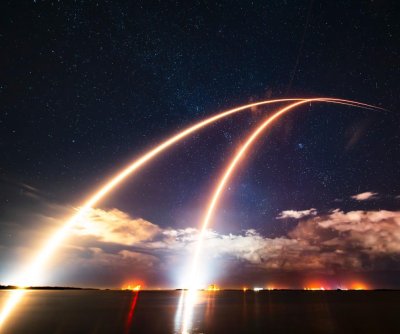SpaceX superimposed this image of two Falcon 9 rockets from Kennedy Space Center and Cape Canaveral Launch Complex overnight Saturday. Image by SpaceX/X
Nov. 15 (UPI) — SpaceX launched two rockets with a total of 58 Starlink Internet satellites about 3 1/2 hours apart overnight Saturday in the private company’s quickest turnaround from Florida’s Space Coast.
In all, there have been a record 98 missions this year from the adjacent Kennedy Space Center or Cape Canaveral Space Force Station. The record of 94 was broken on Monday.
Originally, there was supposed to be a 48-minute turnaround but the second launch was delayed by 2 hours and 49 minutes.
The two launches at 10:08 p.m. EST Friday and 1:44 a.m. Saturday — split by three hours and 36 minutes — beat the doubleheader turnaround of 4 hours and 12 minutes by SpaceX in March 2023. The launches were under clear skies, Florida Today reported.
In 1966, NASA launched two spacecraft 1 hour and 37 minutes apart in Florida with Gemini 11 crew and its Agena target vehicle, which was used to practice orbital space rendezvous and docking techniques.
It is not the quickest doubleheader by SpaceX but the other one occurred in different states.
On Aug. 31, 2024, two Falcon 9 missions were just 65 minutes apart. One flew from Cape Canaveral and the other lifted off from Vandenberg Space Force Base in California.
Both first stages in Florida landed on droneships in the Atlantic east of The Bahamas.
The first Falcon 9 lifted off from Pad 39A at Kennedy Space Center. The Falcon 9’s first stage landed in the Atlantic Ocean on drone ship “A Shortfall of Gravitas” about 8.5 minutes after liftoff. It was the eighth mission for the first stage.
The second Falcon 9 went off from Cape Canaveral’s Pad 40. About 8 1/2 minutes later, the first stage landed on the drone ship “Read the Instructions” and was the 24th mission, including Crew-6.
The first-stage rockets are refurbished at Hangar X.
“It was less than 10 years ago when the idea of recovering a 1st stage was extremely controversial,” Stoke Space CEO and co-founder Andy Lapsa said in a post on X. “Now it’s absurd to even consider anything else.
“Today, the same skepticism surrounds 2nd stage reuse, but it won’t be long until that, too, is archaic.”
He shared video footage of Blue Origin’s New Glenn booster landing Thursday.
The New Glenn launch was part of a doubleheader at Cape Canaveral, which were 6 hours and 9 minutes apart.
The New Glenn rocket deployed NASA’s Mars-bound ESCAPADE spacecraft into low-Earth orbit at 3:55 p.m. Then at 10:04 p.m., United Launch Alliance sent up an Atlas V rocket, deploying a Viasat communications satellite.
With the two launches, there are now more than 8,900 operational Starlink satellites.

